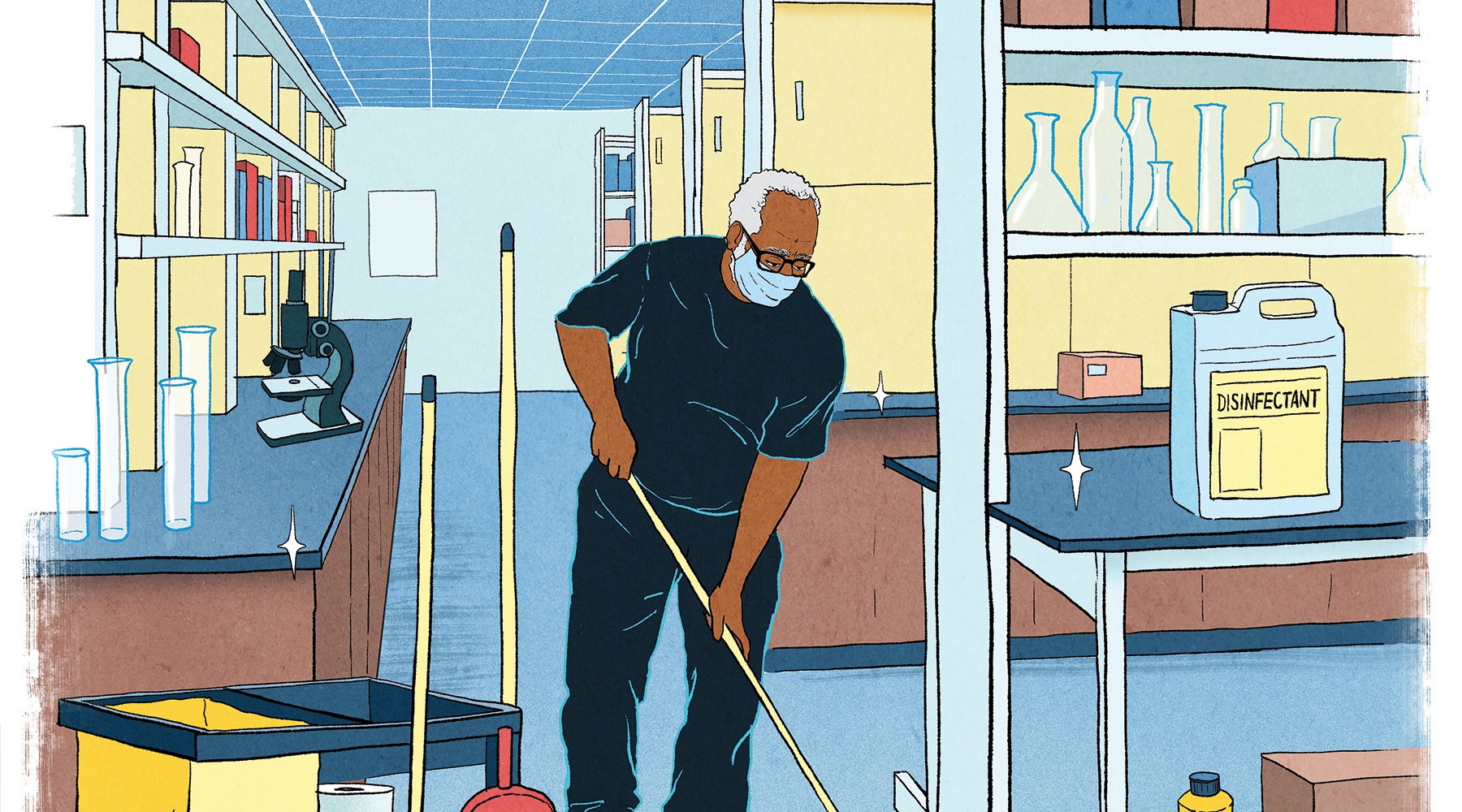So, 2020. Not quite the 366 days any of us were expecting, huh?
But we all found a way to muddle through. And the scientists, physicians and staff of OMRF were no different.
For most employees, the emergence of Covid-19 in March brought a months-long shutdown of onsite activities. Throughout the spring, only a handful of staff members, the so-called skeleton crew, continued coming into the Oklahoma City research campus: technicians who maintained cell lines and experimental animals (mice, worms, fruit flies, fish and frogs); health care providers who continued to see patients in OMRF’s two clinics; and facilities staff who tended to equipment and mechanical systems and kept the premises clean and virus-free.
 Surface transmission was a major worry early in the pandemic, so housekeeping staff sanitized high-touch surfaces exhaustively, wiping down thousands of handrails, door handles and light switches multiple times each day. Monthly, they used nearly 10,000 ounces of disinfectant. Despite the added workload, “We didn’t miss a beat,” says Barry Antwine, who’s been a part of OMRF’s housekeeping team for 18 years. Crew members even found an unexpected silver lining, he says. “We did some deeper cleaning in the labs because there were fewer people around.”
Surface transmission was a major worry early in the pandemic, so housekeeping staff sanitized high-touch surfaces exhaustively, wiping down thousands of handrails, door handles and light switches multiple times each day. Monthly, they used nearly 10,000 ounces of disinfectant. Despite the added workload, “We didn’t miss a beat,” says Barry Antwine, who’s been a part of OMRF’s housekeeping team for 18 years. Crew members even found an unexpected silver lining, he says. “We did some deeper cleaning in the labs because there were fewer people around.”
Meanwhile, scientists worked remotely, using the lockdown to compile and analyze data from previous experiments, write papers and submit grant proposals. In June, OMRF loosened constraints, allowing researchers and their staffs to return onsite. “Everybody was really ready and happy to get back,” says Dr. David Forsthoefel, who studies regenerative medicine in his OMRF lab.
With strict masking and physical distancing requirements, scientists resumed experiments. Staggered shifts helped minimize density, and Zoom sessions replaced in-person meetings. In the fall, a weekly employee testing program added another layer of protection. “I’ve felt really good coming into work, even during the worst stretches of the pandemic,” says Cindy Carter, a lab manager at OMRF. Through year’s end, testing had identified fewer than 20 infected staffers, with no episodes of onsite spread among foundation employees.
“This program has proven very effective at keeping our workforce safe and avoiding outbreaks,” says Vice President of Human Resources Courtney Greenwood. “It’s helped us maintain our laboratory operations, and we’ll continue as long as the virus remains a threat.” By December, nearly 400 employees had returned to campus, down only 20% from pre-pandemic headcounts.
Remarkably, despite 2020’s many obstacles, research productivity remained in line with previous years: Competitive grant funding, patent disclosures and scientific publications met or exceeded 2019 levels. OMRF earned second place among the state’s large employers in The Oklahoman’s 2020 Top Workplaces competition, also receiving a nod in the Top Workplaces USA national survey.
“On paper, it looks like just another solid year,” says OMRF President Dr. Stephen Prescott. “But it’s hard to imagine headwinds stronger than those we faced in 2020.”
That resilience bodes well for 2021. Because when it comes to finding new treatments for disease, awaiting the pandemic’s end is a luxury patients and their families simply do not have.
Illustration by Antoine Doré (@antoinedoreart @levycreative)
—
Read more from OMRF’s 2020 Annual Report
New Hope for Treating Vision Loss
A Homecoming of Sorts
Honoring a Recovered Texan
An Anti-Aging Pill?
Old Drug, New Tricks
From Bedside to Bench
Healing Broken Hearts
How 2020 Changed Science



